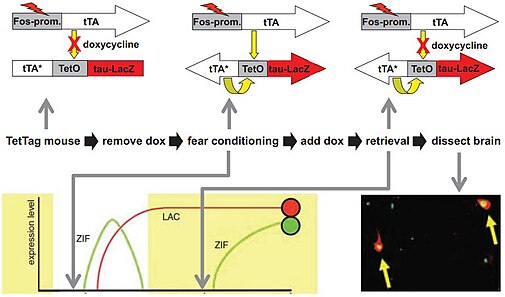
The TetTag mouse is a bi-transgenic mutant used in neuroscience research that expresses a persistent marker (e.g. beta-galactosidase) under control of the immediate early gene fos. This mouse strain allows the stable labeling of activated neurons in mice in a defined time window of several hours.
Description
Two independently generated transgenic strains were crossed to produce the TetTag strain. In the first transgenic construct, the tetracycline-controlled transactivator (tTA) protein and a two hour half-life Green Fluorescent Protein (shEGFP) are expressed under the direction of the fos minimal promoter. The second transgenic construct expresses a nuclear-localizing beta-galactosidase gene and the tetracycline regulated transactivator (tTA) under the control of the TetO tetracycline-responsive regulatory element.
Memory research
The TetTag mouse allows researchers to label activated neurons during a learning experiment (e.g. fear conditioning, water maze training). When the memory is retrieved days later, the acutely activated neurons can be labeled by immunohistochemistry against immediate early genes. These experiments test whether the same neurons are responsible for storing and retrieving a memory, a key question to understand the cellular mechanism of memory.
Limitations
The removal of doxycycline from the chow opens the window for activity-dependent labeling, but it takes several hours for the drug to be cleared from the brain. Thus, the labeling window is not very precise in time. Also, it is not entirely clear which activity patterns lead to Fos activation in neurons.
References
- Reijmers, Leon; Mayford, Mark (2009). "Genetic control of active neural circuits". Frontiers in Molecular Neuroscience. 2: 27. doi:10.3389/neuro.02.027.2009. PMC 2802553. PMID 20057936.
- ^ Reijmers, Leon G.; Perkins, Brian L.; Matsuo, Naoki; Mayford, Mark (2007-08-31). "Localization of a stable neural correlate of associative memory". Science. 317 (5842): 1230–1233. Bibcode:2007Sci...317.1230R. doi:10.1126/science.1143839. ISSN 1095-9203. PMID 17761885. S2CID 37837129.
- Navabpour, Shaghayegh; Kwapis, Janine L.; Jarome, Timothy J. (1 January 2020). "A neuroscientist's guide to transgenic mice and other genetic tools". Neuroscience & Biobehavioral Reviews. 108: 732–748. doi:10.1016/j.neubiorev.2019.12.013. ISSN 0149-7634. PMC 8049509. PMID 31843544.
- Liu, Xu; Ramirez, Steve; Pang, Petti T.; Puryear, Corey B.; Govindarajan, Arvind; Deisseroth, Karl; Tonegawa, Susumu (2012). "Optogenetic stimulation of a hippocampal engram activates fear memory recall". Nature. 484 (7394): 381–385. Bibcode:2012Natur.484..381L. doi:10.1038/nature11028. ISSN 0028-0836. PMC 3331914. PMID 22441246.
- Lamothe-Molina, Paul J.; Franzelin, Andreas; Beck, Lennart; Li, Dong; Auksutat, Lea; Fieblinger, Tim; Laprell, Laura; Alhbeck, Joachim; Gee, Christine E.; Kneussel, Matthias; Engel, Andreas K.; Hilgetag, Claus C.; Morellini, Fabio; Oertner, Thomas G. (2022-10-26). "ΔFosB accumulation in hippocampal granule cells drives cFos pattern separation during spatial learning". Nature Communications. 13 (1): 6376. Bibcode:2022NatCo..13.6376L. doi:10.1038/s41467-022-33947-w. ISSN 2041-1723. PMC 9606265. PMID 36289226.
- Anisimova, Margarita; Lamothe-Molina, Paul J.; Franzelin, Andreas; Aberra, Aman S.; Hoppa, Michael B.; Gee, Christine E.; Oertner, Thomas G. (2023-09-05). Neuronal FOS reports synchronized activity of presynaptic neurons (Report). BioRxiv. doi:10.1101/2023.09.04.556168.